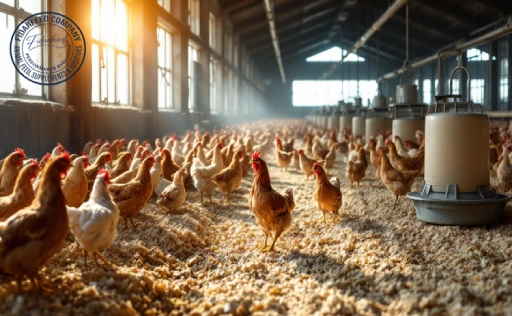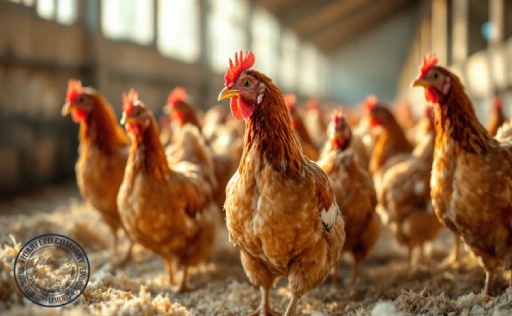Introduction: Why Broiler Chicken Health Should Be Your Top Priority Today
Broiler Chicken Health and Signs of Dysentery are becoming increasingly important concerns as the poultry industry continues to expand. With high stocking densities, fast growth cycles, and the constant pressure to produce more in less time, even minor health issues can snowball into major problems. One such issue that often flies under the radar until it’s too late is dysentery.
Dysentery in broiler chickens isn’t just a health issue—it’s a business risk. Left undetected or untreated, it can reduce flock performance, increase mortality, and cut into your bottom line. Whether you’re an experienced poultry farmer or just getting started, understanding how to recognize and respond to signs of dysentery can make a big difference. So, let’s dive deeper into this disease, explore the early warning signs, and discover how to keep your flock—and your profits—healthy and strong.
What Is Dysentery in Broiler Chickens? Key Facts Every Breeder Should Know
Dysentery is a severe intestinal condition often associated with inflammation, diarrhea, and in some cases, blood in the droppings. In broilers, this condition can be triggered by various factors, including bacterial infections such as Clostridium perfringens, viral pathogens, or protozoan parasites like Eimeria spp. (coccidiosis).
Learn more about: Active Probiotic Yeast for Poultry
Dysentery disrupts the normal digestive process, leading to poor nutrient absorption and dehydration. In environments where stress is high and sanitation is compromised, the disease can spread quickly through a flock, affecting performance within days. It’s more common in young birds, especially during the critical early growth stages when their immune systems are still developing.
Early Signs of Dysentery in Broilers: What to Watch for First
The key to protecting broiler chicken health lies in quick detection. One of the first signs you might notice is a change in the consistency and color of droppings. Watery or foamy feces, sometimes laced with mucus or blood, should raise immediate red flags.
Learn more about: Smart Chicken Waste Management: Sustainable Solutions for Poultry Farmers
You may also notice some birds becoming less active or separating from the group. Sudden increases in mortality, or a noticeable drop in feed consumption, can also signal that something isn’t right. Pay close attention during daily inspections—early intervention can mean the difference between recovery and major flock loss.
Physical Symptoms of Dysentery: Spot These Broiler Health Red Flags
Dysentery in broilers manifests in several physical symptoms. Watch out for:
-
Dehydration: Birds may appear shriveled or have dry, sunken eyes.
-
Weight loss: Sick birds often stop gaining weight, and some may even begin to lose it.
-
Soiled vents and feathers: A dirty vent area is a common symptom of continuous diarrhea.
Learn more about: Early Signs of Marek’s Disease in Chickens: How to Detect and Act Fast
-
Pale combs and wattles: Poor circulation due to dehydration or toxin absorption can change coloration.
-
Hunched posture: A bird that looks like it’s huddling in discomfort may be suffering from gut pain.
Each of these symptoms, on its own, might not point to dysentery—but when they occur together, action is needed.
Behavior Changes That Signal Poor Broiler Chicken Health
Behavior is one of the most powerful indicators of health in animals. When broilers aren’t feeling well, they often behave differently. Look for:
-
Less movement: Sick birds often isolate themselves from the flock.
-
Reduced pecking and foraging: If feed and water intake drop, it’s a warning.
Learn more about: Sudden Dietary Changes and Broiler Performance: Causes, Effects, and Solutions
-
Increased resting or sleeping: Lethargy is a common symptom of intestinal distress.
-
Crowding in corners or under heaters: Birds experiencing chills or weakness may try to stay warm.
Small shifts in behavior might be overlooked during a busy day—but they can give you the earliest heads-up that something’s wrong.
What Causes Dysentery in Broiler Chickens? The Common Culprits
Understanding the causes of dysentery helps you prevent it. Some common culprits include:
-
Pathogenic bacteria: Especially Clostridium perfringens, which can cause necrotic enteritis.
-
Poor sanitation: Dirty water lines, feeders, and litter provide a breeding ground for pathogens.
-
Inconsistent feed quality: Contaminated or unbalanced feed can disrupt gut flora.
Learn more about: how to breed broiler chickens
-
Stress: Overcrowding, temperature fluctuations, or transport can weaken immune defenses.
-
Coccidiosis: A common intestinal parasite in poultry, often leading to secondary infections.
Addressing these root causes with a solid management plan is the first step in keeping dysentery at bay.
How Dysentery Affects Broiler Production and Profitability
Dysentery doesn’t just make your birds sick—it hits your bottom line hard. Here’s how:
-
Reduced feed efficiency: Sick birds eat less and convert less feed into weight.
-
Increased mortality rates: Even a 2–3% rise in deaths can drastically affect revenue.
-
Higher treatment costs: Medications, vet consultations, and labor all add up.
Learn more about: how to prevent marek’s disease in chickens
-
Delayed market weight: Birds may take longer to reach the desired slaughter weight, impacting turnover.
-
Reputation risk: Consistent health issues can tarnish supplier credibility.
For example, a study published in Poultry Science showed that flocks affected by Clostridium infections had up to 12% lower final weights and significantly reduced uniformity—key factors buyers look for.
Practical Prevention Tips: Keeping Broiler Chicken Health in Check
Good management is your best line of defense. Here are some proven prevention methods:
-
Maintain hygiene: Clean drinkers and feeders daily. Disinfect sheds thoroughly between flocks.
-
Control litter moisture: Wet bedding promotes bacterial growth—keep it dry and turned regularly.
-
Improve ventilation: Good airflow reduces stress and moisture buildup.
Learn more about: How to Treat Arthritis in Chickens: Key Strategies for Healthier Breeder Birds
-
Monitor feed and water quality: Use quality feed ingredients and test water regularly.
-
Use probiotics or acidifiers: These can help balance gut flora and reduce the risk of enteric disease.
Prevention is always cheaper and easier than treatment, especially when it comes to intestinal diseases.
Treating Dysentery: When and How to Take Action
Once symptoms appear, act fast. Here’s how:
-
Isolate affected birds to limit the spread.
-
Ensure clean water access—dehydrated birds need immediate rehydration.
Learn more about: The Chicken Egg Production Cycle: A Comprehensive Overview
-
Administer appropriate medication—antibiotics for bacterial causes (under vet guidance), anticoccidials if Eimeria is involved.
-
Support gut recovery with vitamin supplements and electrolytes.
Remember, treatment must be targeted. Don’t guess—diagnostics from a vet or lab can guide you toward the most effective solution.
Broiler Chicken Health Emergencies: When to Call the Vet for Dysentery
If you observe:
-
Sudden mortality increases
-
Bloody or foul-smelling droppings
Learn more about: The Ultimate Guide to Broiler House Ventilation
-
Unexplained weight loss in multiple birds
-
Continued diarrhea despite initial treatment
…it’s time to call in a professional. Delays can lead to outbreaks that wipe out weeks of progress. Vets can also help you create a long-term biosecurity and vaccination plan to prevent future issues.
Conclusion: Take Control of Broiler Chicken Health—Catch Dysentery Before It Spreads
Broiler chicken health is your farm’s lifeline. Recognizing the signs of dysentery early, understanding the causes, and acting with confidence can save your flock—and your profits. Whether you’re new to the industry or have decades of experience, staying proactive is key.
Have questions about dysentery or want to share what’s worked for your flock? Leave a comment below—we’d love to hear from you. Let’s keep broiler farming healthy, productive, and thriving—together.









